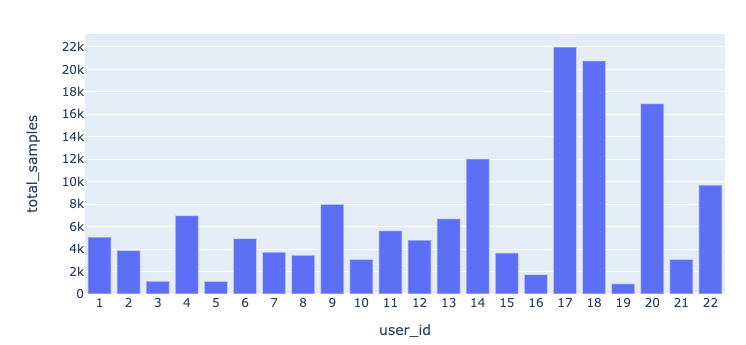Example ML Project for Time Series Classification - User Identification
"The dataset collects data from an Android smartphone positioned in the chest pocket. Accelerometer Data are collected from 22 participants walking in the wild over a predefined path. The dataset is intended for Activity Recognition research purposes. It provides challenges for identification and authentication of people using motion patterns."
Dataset: https://archive.ics.uci.edu/ml/datasets/User+Identification+From+Walking+Activity#
22 different users (classes), can see some class imbalance. Around ~150 total raw sensor samples.
full_classify_workflow_rforest.ipynb
- proper train / test split for time series data
- Feature Engineering with time series windowing
- Exploratory Data Analysis
- Multiclass Classification with Scikit-Learn
- Evaluation Metrics and Plots
- GridSearchCV Example
full_classify_workflow_rforest_1vsrest.ipynb
- copy of full_classify_workflow_rforest.ipynb but trying 1 vs all ML classifier
sktime_rocket_classify.ipynb
- Time Series classification using sktime library, ROCKET (random convolutional kernels) time series classifer model which has shown state of the art performance in a range of time series classification benchmarks
Random forest classification model was built from using different size windowing / lag features on dataset.
| Classifier | Test Accuracy | Balanced Test Accuracy | Weighted Avg. Precision | Weighted Avg. F1 Score |
|---|---|---|---|---|
| RF Window 2 | 0.39 | 0.37 | 0.37 | 0.37 |
| RF Window 5 | 0.50 | 0.46 | 0.49 | 0.48 |
| RF Window 10 | 0.56 | 0.51 | 0.55 | 0.54 |
| RF Window 25 | 0.60 | 0.54 | 0.60 | 0.58 |
| RF Window 50 | 0.61 | 0.54 | 0.62 | 0.60 |
| ROCKET Window 100 - step size 5 | 0.70 | 0.61 | 0.70 | 0.69 |
Increasing the window size shows decreasing performance gain, not getting higher than ~60% test accuracy.
ROCKET outperforms the Random Forest classifiers signifcantly, using only the raw x,y,z initial 3 features.
- https://github.com/alan-turing-institute/sktime/blob/main/examples/02_classification_univariate.ipynb
- https://github.com/alan-turing-institute/sktime/blob/main/examples/03_classification_multivariate.ipynb
- https://github.com/alan-turing-institute/sktime/blob/main/examples/rocket.ipynb
- http://www.timeseriesclassification.com/index.php
- ROCKET: Exceptionally fast and accurate time series classification using random convolutional kernels. - https://github.com/angus924/rocket
